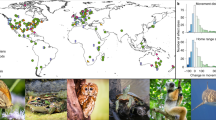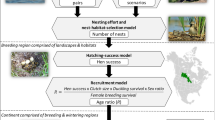Abstract
The ability to freely move across the landscape to track the emergence of nutritious spring green-up (termed ‘green-wave surfing’) is key to the foraging strategy of migratory ungulates. Across the vast landscapes traversed by many migratory herds, habitats are being altered by development with unknown consequences for surfing. Using a unique long-term tracking dataset, we found that when energy development occurs within mule deer (Odocoileus hemionus) migration corridors, migrating animals become decoupled from the green wave. During the early phases of a coalbed natural gas development, deer synchronized their movements with peak green-up. But faced with increasing disturbance as development expanded, deer altered their movements by holding up at the edge of the gas field and letting the green wave pass them by. Development often modified only a small portion of the migration corridor but had far-reaching effects on behaviour before and after migrating deer encountered it, thus reducing surfing along the entire route by 38.65% over the 14-year study period. Our study suggests that industrial development within migratory corridors can change the behaviour of migrating ungulates and diminish the benefits of migration. Such disruptions to migratory behaviour present a common mechanism whereby corridors become unprofitable and could ultimately be lost on highly developed landscapes.
This is a preview of subscription content, access via your institution
Access options
Access Nature and 54 other Nature Portfolio journals
Get Nature+, our best-value online-access subscription
$29.99 / 30 days
cancel any time
Subscribe to this journal
Receive 12 digital issues and online access to articles
$119.00 per year
only $9.92 per issue
Buy this article
- Purchase on Springer Link
- Instant access to full article PDF
Prices may be subject to local taxes which are calculated during checkout




Similar content being viewed by others
Data availability
GPS locations and energy development footprints can be found in the following Dryad Data Digital Repository: https://doi.org/10.5061/dryad.7d7wm37z5. MODIS data are available from the U.S. Geological Survey LP DAAC (https://lpdaac.usgs.gov/).
References
Bolger, D. T., Newmark, W. D., Morrison, T. A. & Doak, D. F. The need for integrative approaches to understand and conserve migratory ungulates. Ecol. Lett. 11, 63–77 (2008).
Fryxell, J. M., Greever, J. & Sinclair, A. R. E. Why are migratory ungulates so abundant. Am. Nat. 131, 781–798 (1988).
Holdo, R. M., Holt, R. D., Sinclair, A. R., Godley, B. J. & Thirgood, S. in Animal Migration: A Synthesis (eds Milner-Gulland, E. J. et al.) 131–143 (Oxford Univ. Press, 2011).
Bauer, S. & Hoye, B. J. Migratory animals couple biodiversity and ecosystem functioning worldwide. Science 344, 1242552 (2014).
Middleton, A. D. et al. Conserving transboundary wildlife migrations: recent insights from the Greater Yellowstone Ecosystem. Front. Ecol. Environ. 18, 83–91 (2020).
Aikens, E. O. et al. Wave-like patterns of plant phenology determine ungulate movement tactics. Curr. Biol. 30, 3444–3449 (2020).
Mueller, T. & Fagan, W. F. Search and navigation in dynamic environments—from individual behaviors to population distributions. Oikos 117, 654–664 (2008).
Fryxell, J. M. Forage quality and aggregation by large herbivores. Am. Nat. 138, 478–498 (1991).
Drent, R., Ebbinge, B. & Weijand, B. Balancing the energy budgets of arctic-breeding geese throughout the annual cycle: a progress report. Verh. Ornithol. Ges. Bayern 23, 239–264 (1978).
van der Graaf, S. A. J., Stahl, J., Klimkowska, A., Bakker, J. P. & Drent, R. H. Surfing on a green wave—how plant growth drives spring migration in the Barnacle Goose Branta leucopsis. Ardea 94, 567–577 (2006).
Merkle, J. A. et al. Large herbivores surf waves of green-up during spring. Proc. R. Soc. B. 283, 20160456 (2016).
Aikens, E. O. et al. The greenscape shapes surfing of resource waves in a large migratory herbivore. Ecol. Lett. 20, 741–750 (2017).
Middleton, A. D. et al. Green-wave surfing increases fat gain in a migratory ungulate. Oikos https://doi.org/10.1111/oik.05227 (2018).
Jesmer, B. R. et al. Is ungulate migration culturally transmitted? Evidence of social learning from translocated animals. Science 361, 1023–1025 (2018).
Sawyer, H. et al. A framework for understanding semi‐permeable barrier effects on migratory ungulates. J. Appl. Ecol. 50, 68–78 (2013).
Kauffman, M. J. et al. Mapping out a future for ungulate migrations. Science 372, 566–569 (2021).
Doherty, T. S., Hays, G. C. & Driscoll, D. A. Human disturbance causes widespread disruption of animal movement. Nat. Ecol. Evol. 5, 513–519 (2021).
Berry, J. Aspects of wildebeest Connochaetes taurinus ecology in the Etosha National Park—a synthesis for future management. Madoqua 1997, 137–148 (1997).
Williamson, D. & Williamson, J. Botswana’s fences and the depletion of Kalahari wildlife. Oryx 18, 218–222 (1984).
Northrup, J. M. & Wittemyer, G. Characterising the impacts of emerging energy development on wildlife, with an eye towards mitigation. Ecol. Lett. 16, 112–125 (2013).
Kauffman, M. J., Meacham, J. E., Sawyer, H., Rudd, W. & Ostlind, E. Wild Migrations: Atlas of Wyoming’s Ungulates (Oregon State Univ. Press, 2018).
Wyckoff, T. B., Sawyer, H., Albeke, S. E., Garman, S. L. & Kauffman, M. J. Evaluating the influence of energy and residential development on the migratory behavior of mule deer. Ecosphere 9, e02113 (2018).
Lendrum, P. E., Anderson, C. R. Jr., Monteith, K. L., Jenks, J. A. & Bowyer, R. T. Migrating mule deer: effects of anthropogenically altered landscapes. PLoS ONE 8, e64548 (2013).
Lendrum, P. E., Anderson, C. R. Jr, Long, R. A., Kie, J. G. & Bowyer, R. T. Habitat selection by mule deer during migration: effects of landscape structure and natural‐gas development. Ecosphere 3, 82 (2012).
Sawyer, H. & Kauffman, M. J. Stopover ecology of a migratory ungulate. J. Anim. Ecol. 80, 1078–1087 (2011).
Sawyer, H., LeBeau, C. W., McDonald, T. L., Xu, W. & Middleton, A. D. All routes are not created equal: an ungulate’s choice of migration route can influence its survival. J. Appl. Ecol. 56, 1860–1869 (2019).
Bischof, R. et al. A migratory northern ungulate in the pursuit of spring: jumping or surfing the green wave? Am. Nat. 180, 407–424 (2012).
Skarin, A., Nellemann, C., Rönnegård, L., Sandström, P. & Lundqvist, H. Wind farm construction impacts reindeer migration and movement corridors. Landsc. Ecol. 30, 1527–1540 (2015).
Mysterud, A., Langvatn, R., Yoccoz, N. G. & Stenseth, N. C. Plant phenology, migration and geographical variation in body weight of a large herbivore: the effect of a variable topography. J. Anim. Ecol. 70, 915–923 (2001).
Johnson, H. E. et al. Increases in residential and energy development are associated with reductions in recruitment for a large ungulate. Glob. Change Biol. 23, 578–591 (2017).
Sawyer, H., Korfanta, N. M., Nielson, R. M., Monteith, K. L. & Strickland, D. Mule deer and energy development—long-term trends of habituation and abundance. Glob. Change Biol. 23, 4521–4529 (2017).
Sawyer, H., Lambert, M. S. & Merkle, J. A. Migratory disturbance thresholds with mule deer and energy development. J. Wildl. Manag. 84, 930–937 (2020).
Uezu, A., Metzger, J. P. & Vielliard, J. M. E. Effects of structural and functional connectivity and patch size on the abundance of seven Atlantic Forest bird species. Biol. Conserv. 123, 507–519 (2005).
Keeley, A. T. H., Beier, P. & Jenness, J. S. Connectivity metrics for conservation planning and monitoring. Biol. Conserv. 255, 109008 (2021).
Abrahms, B. et al. Emerging perspectives on resource tracking and animal movement ecology. Trends Ecol. Evol. 36, 308–320 (2021).
Aikens, E. O. et al. Migration distance and maternal resource allocation determine timing of birth in a large herbivore. Ecology 102, e03334 (2021).
Aikens, E. O. et al. Drought reshuffles plant phenology and reduces the foraging benefit of green-wave surfing for a migratory ungulate. Glob. Change Biol. 26, 4215–4225 (2020).
Sawyer, H., Merkle, J. A., Middleton, A. D., Dwinnell, S. P. H. & Monteith, K. L. Migratory plasticity is not ubiquitous among large herbivores. J. Anim. Ecol. 88, 450–460 (2019).
Schlaepfer, M. A., Runge, M. C. & Sherman, P. W. Ecological and evolutionary traps. Trends Ecol. Evol. 17, 474–480 (2002).
Delibes, M., Gaona, P. & Ferreras, P. Effects of an attractive sink leading into maladaptive habitat selection. Am. Nat. 158, 277–285 (2001).
Sawyer, H., Kauffman, M. J., Nielson, R. M. & Horne, J. S. Identifying and prioritizing ungulate migration routes for landscape-level conservation. Ecol. Appl. 19, 2016–2025 (2009).
Sawyer, H., Hayes, M., Rudd, B. & Kauffman, M. J. The Red Desert to Hoback Mule Deer Migration Assessment (Univ. Wyoming, 2014).
Berger, J., Young, J. K. & Berger, K. M. Protecting migration corridors: challenges and optimism for Mongolian saiga. PLoS Biol. 6, e165 (2008).
Sikes, R. S. & Gannon, W. L. Guidelines of the American Society of Mammalogists for the use of wild mammals in research. J. Mammal. 92, 235–253 (2011).
Vermote, E. MOD09A1 Surface Reflectance 8-day L3 Global 500m SIN Grid V006 (NASA EOSDIS Land Processes DAAC, 2015).
Pettorelli, N., Mysterud, A., Yoccoz, N. G., Langvatn, R. & Stenseth, N. C. Importance of climatological downscaling and plant phenology for red deer in heterogeneous landscapes. Proc. R. Soc. B. 272, 2357–2364 (2005).
Pettorelli, N. et al. Using the satellite-derived NDVI to assess ecological responses to environmental change. Trends Ecol. Evol. 20, 503–510 (2005).
Hamel, S., Garel, M., Festa-Bianchet, M., Gaillard, J. M. & Cote, S. D. Spring normalized difference vegetation index (NDVI) predicts annual variation in timing of peak faecal crude protein in mountain ungulates. J. Appl. Ecol. 46, 582–589 (2009).
Geremia, C. et al. Migrating bison engineer the green wave. Proc. Natl Acad. Sci. USA 116, 25707–25713 (2019).
Acknowledgements
The Wyoming Game and Fish Department and the U.S. Geological Survey Wyoming Landscape Conservation Initiative supported this work. Special thanks to: S. L. Garman and J. L. McBeth, US Geological Survey, Geosciences and Environmental Change Science Center who assisted with collection and development of well pad data and to J. A. Merkle who provided derived NDVI and IRG products. GPS collaring was funded by the Bureau of Land Management, Anadarko Petroleum Company, Warren Resources and the Wyoming Game and Fish Department. E.O.A. was supported by the Wyoming NASA Space Grant Consortium Graduate Fellowship (NASA grant no. NNX15AI08H). Any use of trade, firm or product names is for descriptive purposes only and does not imply endorsement by the US Government. We thank G. Chong and N. Latysh for feedback that improved earlier versions of the manuscript.
Author information
Authors and Affiliations
Contributions
E.O.A., T.B.W., H.S. and M.J.K. conceived the work. H.S. collected the data. E.O.A. and T.B.W. analysed the data. E.O.A., T.B.W. and M.J.K. wrote the manuscript and all authors contributed to revisions.
Corresponding author
Ethics declarations
Competing interests
Like the state (Wyoming Game and Fish Department) and federal (Bureau of Land Management) agencies who supported our research, Anadarko Petroleum Company and Warren Resources helped fund a portion of the study. Neither company had any role in the study design, data interpretation or the preparation of the manuscript. Similarly, H. Sawyer is an employee of Western Ecosystems and, like other co-authors employed by academic institutions, government agencies and NGOs, has no conflict of interest (financial or otherwise) with the study. H. Sawyer collected most of the data, led earlier research efforts in this study system and brought valuable technical expertise to our manuscript.
Peer review
Peer review information
Nature Ecology & Evolution thanks Tim Doherty and the other, anonymous, reviewer(s) for their contribution to the peer review of this work.
Additional information
Publisher’s note Springer Nature remains neutral with regard to jurisdictional claims in published maps and institutional affiliations.
Supplementary information
Supplementary Information
Supplementary Figs. 1–4, Tables 1–6 and text (SM1).
Rights and permissions
About this article
Cite this article
Aikens, E.O., Wyckoff, T.B., Sawyer, H. et al. Industrial energy development decouples ungulate migration from the green wave. Nat Ecol Evol 6, 1733–1741 (2022). https://doi.org/10.1038/s41559-022-01887-9
Received:
Accepted:
Published:
Issue Date:
DOI: https://doi.org/10.1038/s41559-022-01887-9
This article is cited by
-
Migrating mule deer compensate en route for phenological mismatches
Nature Communications (2023)



